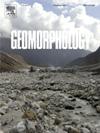Tectonic uplift recorded by the river terraces in the northern flank of East Kunlun Shan
IF 3.1
2区 地球科学
Q2 GEOGRAPHY, PHYSICAL
引用次数: 0
Abstract
The East Kunlun Shan offers key insights into plateau growth on the northeastern Tibetan Plateau. However, the uplift history of this region over the past several million years remains poorly understood. To address this, we combined cosmogenic nuclide burial dating and K-feldspar pIRIR dating with geomorphic indices and valley morphology analyses to reconstruct the Quaternary uplift and sedimentary history along the Golmud and Kaimuqi Rivers. Our results show that river sediments began accumulating before 1.41 Ma, and their elevation, similar to or lower than the present Golmud River bed, indicates that the river reached its current level by this time. Cycles of sediment fill and downcutting since 1.41 Ma were primarily driven by climatic changes, as no bedrock incision was observed. Erosion rates (20–83 mm/ka), channel steepness indices, valley width, and valley floor width-valley height ratios consistently suggest minimal or no tectonic uplift over the past several million years. These findings confirm the inactivity of the North Kunlun Fault since the Quaternary and highlight the dominant role of long-term aridification and episodic wetting events in shaping the region's geomorphic evolution. This study provides crucial insights into the interplay between tectonic stability and climate, advancing our understanding of landscape evolution in tectonically stable regions of the Tibetan Plateau.
求助全文
约1分钟内获得全文
求助全文
来源期刊

Geomorphology
地学-地球科学综合
CiteScore
8.00
自引率
10.30%
发文量
309
审稿时长
3.4 months
期刊介绍:
Our journal''s scope includes geomorphic themes of: tectonics and regional structure; glacial processes and landforms; fluvial sequences, Quaternary environmental change and dating; fluvial processes and landforms; mass movement, slopes and periglacial processes; hillslopes and soil erosion; weathering, karst and soils; aeolian processes and landforms, coastal dunes and arid environments; coastal and marine processes, estuaries and lakes; modelling, theoretical and quantitative geomorphology; DEM, GIS and remote sensing methods and applications; hazards, applied and planetary geomorphology; and volcanics.
 求助内容:
求助内容: 应助结果提醒方式:
应助结果提醒方式:


